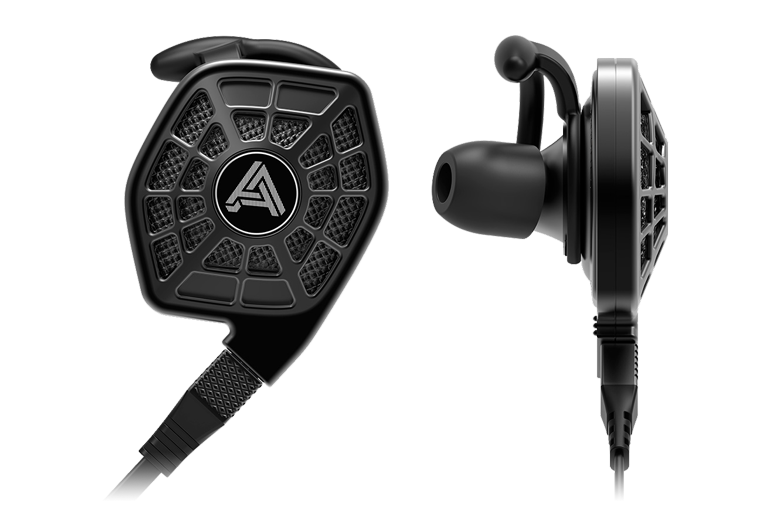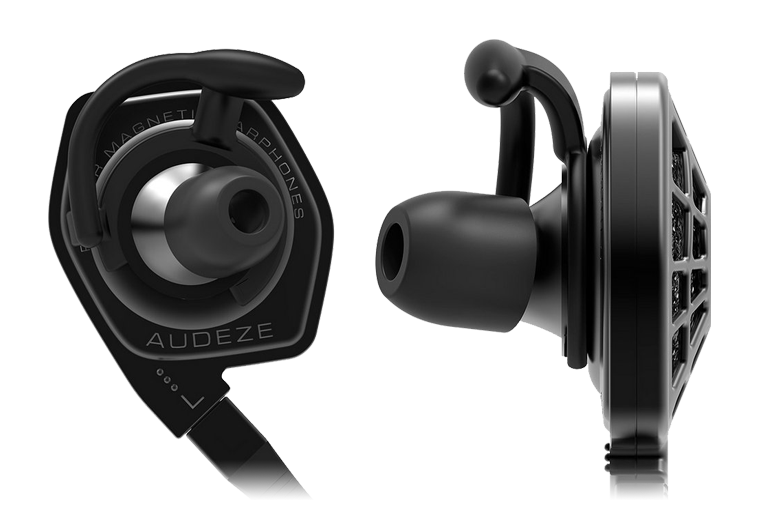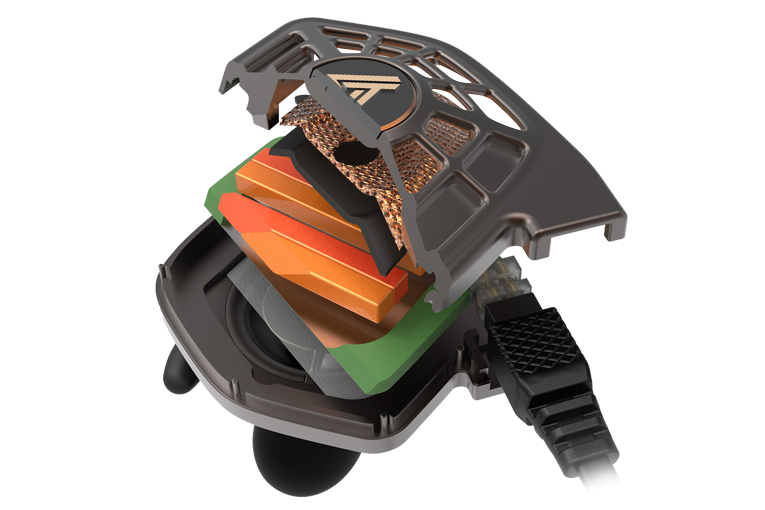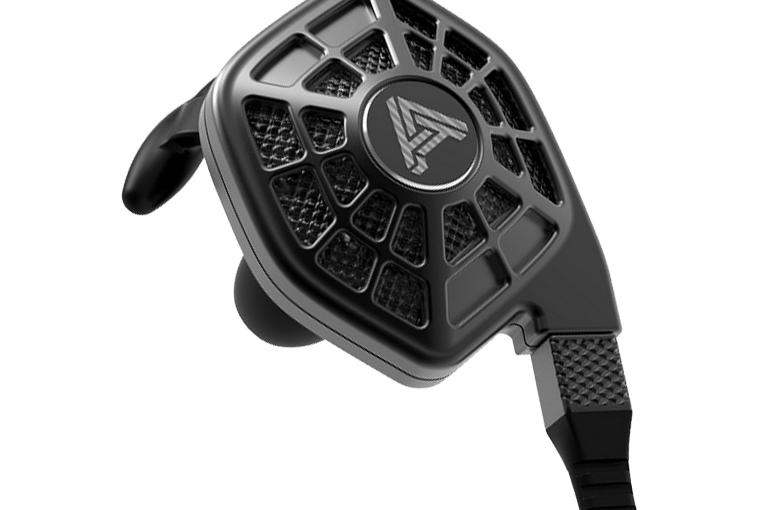Originally published on SoundStage! Xperience
Audeze iSine10 earphones measurements can be found by clicking this link.
 I’ve been reviewing headphones and earphones since 2008, but the Audeze iSine10s are the first I’ve encountered that create their own category. The iSine10s ($399 USD with Lightning and analog cables, $349 with analog cable only) differ from all other earphones not only in their sound, appearance, and the way they work, but even in the ways you’ll use them.
I’ve been reviewing headphones and earphones since 2008, but the Audeze iSine10s are the first I’ve encountered that create their own category. The iSine10s ($399 USD with Lightning and analog cables, $349 with analog cable only) differ from all other earphones not only in their sound, appearance, and the way they work, but even in the ways you’ll use them.
The main difference between the iSine10s and all other earphones (except the step-up model, the $599 iSine20s, and the $899 oBravo ERIB-2a hybrid) is that they use planar-magnetic drivers. Planar-magnetic drivers typically use a Mylar diaphragm to produce sound. (Audeze actually uses a proprietary film rather than Mylar.) The diaphragm is suspended between two metal plates, which are lined with rows of magnets. A wire voice-coil inlaid in the diaphragm accepts the signal from the source device. Planar-magnetic drivers are known for their clear, airy treble, natural-sounding midrange, and sometimes weak bass response. These drivers have been used in headphones and loudspeakers for decades, but in the past few years have enjoyed renewed attention thanks to acclaimed over-ear models from Audeze, HiFiMan, and other companies.

Because the iSine10s’ planar drivers are 1.2” (30mm) across, they can’t fit inside the ear canals, as can typical 10mm dynamic-earphone drivers. So the iSine10s consist of little hexagonal panels that fit outside your ear and look like half of a toy TIE fighter from Star Wars. Because these parts of the iSine10s hang outside the ear, Audeze includes all sorts of hooks that let them grip the inside or outside of the pinnae (the outer ears).
Like most planar-magnetic headphones, the iSine10 earphones are open-backed. (Audeze’s specs describe them as “semi-open,” but my measurements and listening experience suggest that “open-backed” is more accurate.) This means that sounds from all around you can leak into your ears -- something that doesn’t occur with conventional earphones unless they’re equipped with eartips designed to let sound in.
The iSine20s look nearly identical to the iSine10s. The difference is that the iSine20s have a longer voice coil, and thus a slightly higher impedance: 24 ohms, vs. 16 ohms for the iSine10s. Audeze says that this change results in “better control and responsiveness for better bass, clarity, and improved imaging.”
I expected the iSine10s to sound different from other earphones. What I wasn’t prepared for was how different they sounded.
In the box
The $399 version of the iSine10s includes two cables: a standard analog cable tipped with a 3.5mm plug, and Audeze’s Cipher digital cable, which has a Lightning connector compatible with Apple iOS devices. Integrated into the Cipher cable are a digital-to-analog converter (DAC), a digital signal processor (DSP), a headphone amp, and a microphone that lets you take phone calls. Through an iOS app, you can access the DSP’s ten-band EQ to fine-tune the iSine10s’ sound. (The app doesn’t work with the analog connection.) Without the Cipher cable, the iSine10s cost $50 less.
Because the iSine10s are larger than conventional earphones, so is their case -- although it’s still easy to slip into a laptop bag or a coat pocket. The package also includes four types of earhooks, a cleaning brush, and a clip to attach the cable to your shirt or jacket.

The iSine10s come with silicone eartips in three sizes. I prefer that earphones come with tips in four to six sizes, because fit is so critical to the sound. That could be even more of an issue in this case, because the iSine10s’ soundtubes are 7mm in diameter rather than the usual 6mm -- replacement tips won’t be as easy to find. However, the Comply Foam website lists two aftermarket tips available to fit the iSine10s, and Comply tips come in a nice range of sizes.
Use
Fortunately, the largest of the three sizes of eartips fit my slightly oversize ear canals pretty well. I also found that the largest of the earhooks fit my ears well and kept the iSine10s secure -- not secure enough for jogging, but enough that I could walk around my neighborhood without concern that the earphones would fall out.
That walk proved frustrating for a different reason -- the iSine10s didn’t block much environmental noise. If you walk down a busy street while using them, auto noise will mask at least some of the music you’re listening to. You’ll have a similar experience at Starbucks or in the subway -- and forget about using them on airplanes. The iSine10s may be the first earphones that aren’t actually all that well suited for portable use, unless you plan to listen to them in a relatively quiet environment such as an office or library.
The Cipher cable is heavier than the analog cable (28gm vs. 13gm); unless I clipped the Cipher to my clothes, it pulled down on the earphones enough to be a little annoying.
Sound
With earphones or headphones that offer different connection options, it can be tough to decide which configuration to focus on for a review -- especially when one option sounds a lot different from the other, and lets you alter the sound even more than the other option.
It was easy to hear the positive attributes of Audeze’s radical design with nearly any music, and to hear differences between the analog and digital cables. Let’s start with the title track of I Only Have Eyes for You, by Lester Bowie’s Brass Fantasy (256kbps MP3, ECM). This 1985 recording is an audiophile classic for its enormous sense of space -- though taped in a Brooklyn studio, it sounds as if it was recorded in a cathedral. With the analog cable, it was immediately apparent that the iSine10s didn’t sound like earphones at all. To me, they sounded much like a good set of over-ear, open-back headphones. The sound was far more spacious than I’d expect from earphones, and for the first time with earphones, I didn’t detect the resonance of a chamber or soundtube. I hadn’t necessarily noticed those resonances before, but the moment I first heard the iSine10s (at the 2016 Rocky Mountain Audio Fest, I think), I got the impression that other earphones had always added something to the sound that these weren’t.

The imaging of the instruments -- particularly drummer Phillip Wilson’s snare and hi-hat, and Bowie’s trumpet -- sounded far more precise and centered than I’m used to hearing from earphones. That doesn’t mean that the iSine10s were collapsing the soundstage -- I still experienced a huge ambience, and noticed discrete aural images of the horns accompanying Bowie at far left and far right.
I think a lot of enthusiasts might be willing to buy the iSine10s just on the basis of hearing a tune or two with the analog cable. The Cipher cable, however, sounded very different. As my measurements showed, it introduced a big peak at 3kHz, and elevated the mid-treble below about 8kHz from 8 to 12dB. This added brightness was easy to hear with the Bowie recording, and while the sound did seem more detailed and spacious, the sharp increase in treble robbed it of body and warmth. Treble-loving audiophiles would dig it, but as a guy who plays in jazz jam sessions a couple times a week, I know that real instruments don’t sound this bright. I quickly became annoyed and fatigued by the sound.
But I hadn’t yet tried the ten-band equalizer in Audeze’s app. The corrections I dialed in seemed extreme: -1dB at 2kHz, -6dB at 4kHz, -5dB at 8kHz, -5dB at 16kHz. Yet for my taste they were perfect, giving me a neutral balance reminiscent of the Sony MDR-7506s, probably the most popular pro-audio production headphones of all time. But the sound was much more detailed, subtle, and spacious than the MDR-7506s can deliver. This EQ setting sacrificed none of the iSine10s’ irresistible spaciousness and detail, but the timbres of instruments were much more natural, and the bass and the groove returned. Going back to the analog cable now no longer satisfied -- its treble sounded soft, and the midrange not as open, though it was still more open than that of most earphones. So I decided to stick with the Cipher cable for most of my listening, using the EQ settings noted above, and changing them by a dB or two when I felt the music required it.
The Audeze app worked fine with all the music-player apps on my iPod Touch, including Spotify, YouTube, and Amazon Music. It offers two user-defined presets. I could have used another preset or two, because I wanted slightly different settings for instrumental jazz, vocal music, and heavy rock. For example, “Der Meister,” from Rammstein’s Herzeleid (320kbps Ogg Vorbis/Spotify, London), needed little treble reduction: just -2dB at 4, 8, and 16kHz. This level of treble -- higher than my chosen settings but still below the app’s default EQ setting -- lifted the band’s ultra-heavy music out of the mud and let me hear all the instruments and voices clearly without psychoacoustically masking the bass. If I ever thought that earphones, or planar-magnetic drivers, or earphones with planar-magnetic drivers couldn’t rock, this tune at this EQ setting proved me dead wrong.

So many recordings I thought I knew well revealed previously unheard nuances through the iSine10s -- something I rarely find. For example, in the lushly arranged “Down to You,” from Joni Mitchell’s Court and Spark (256kbps MP3, Elektra/Asylum), the character of each instrument was easy to hear, as was its precise position on the soundstage. At the end of the orchestrated middle section, an oboe carries a brief section of the melody, then a clarinet picks it up. I knew the oboe was mostly in the right channel and the clarinet in the left, but through the iSine10s, each instrument had its own sense of space, as if I were hearing both being played in real space, each instrument’s position producing a different acoustical interaction with the room. The cellos’ sound was just as captivating -- I could clearly hear the trebly scrapings of bows against strings, but equally audible was all their gorgeous low-frequency resonance.
Of course, I had to wonder how a more conventional set of earphones, EQed to my liking, would compare with the EQed iSine10s. To find out, I grabbed a set of custom-molded Ultimate Ears Pro Reference earphones, which were tuned in conjunction with Capitol Studios and are widely regarded as having a neutral sound. Powered by the iPod Touch, the UEs sounded a bit tinny in the treble and light in the bass compared with the EQed iSine10s. I tried using the six-band EQ in the Spotify iOS app to hear how close I could get the UEs’ sound to that of the iSine10s. I was able to achieve a similarity of tonal balance, but the UEs’ treble never sounded as smooth or their bass as powerful.
Conclusion
The Audeze iSine10s aren’t for everyone. I take that back: Used with the Cipher cable, their sound is for everyone, especially considering how easily it can be tweaked with the EQ app, and that the result seems to have no audible downsides (other than that, as with almost any other EQ, it gives inexperienced listeners ample opportunity to mess up the sound). But the iSine10s’ use will be limited to the sort of quiet environments in which earphones aren’t typically used. Still, if you want top-notch, audiophile-grade sound you can enjoy at home and easily take along to your office, cubicle, or hotel room, I can’t think of a more practical and cost-effective way to get it. This is $4000 worth of sound for $400.
. . . Brent Butterworth
Associated Equipment
- Sources -- Samsung Galaxy S6 smartphone and Apple iPod Touch (sixth generation)
- Headphone amplifier -- Parasound Halo P 5
Audeze iSine10 Earphones
Price: $399 USD with Cipher and analog cables, $349 with analog cable only.
Warranty: Two years repair or replacement.
Audeze LLC
1559 Sunland Ln,
Costa Mesa, CA 92626
Phone: (714) 581-8010
Fax: (702) 823-0333
E-mail:
Website: www.audeze.com





